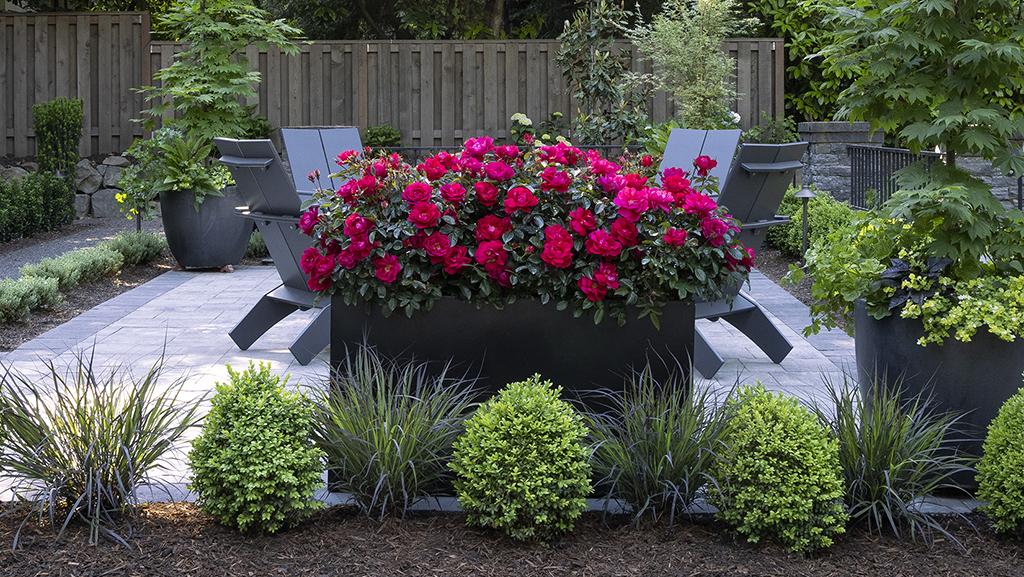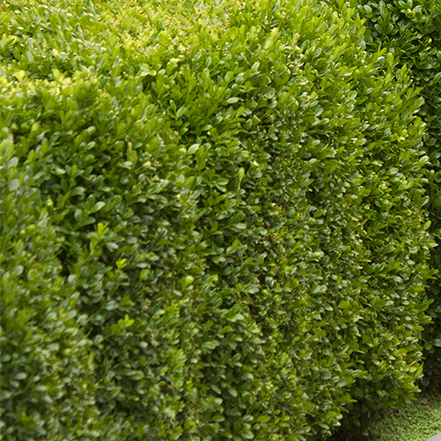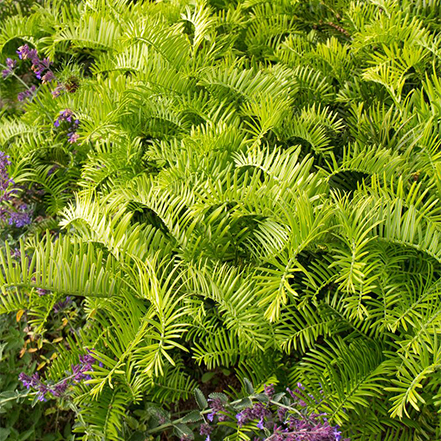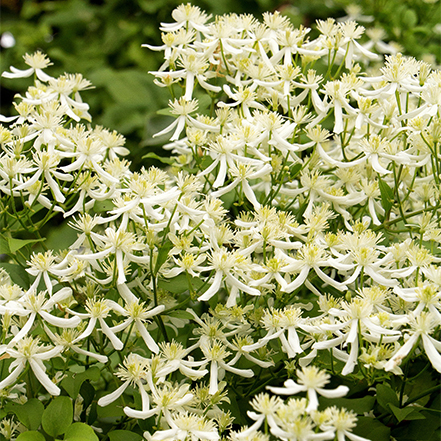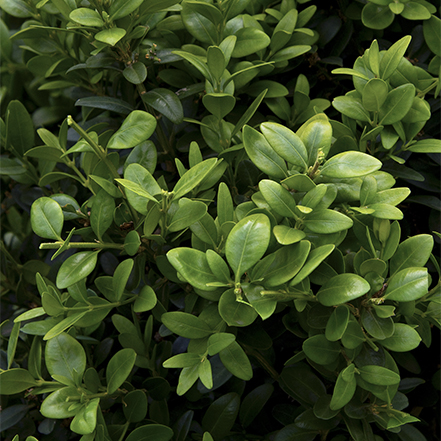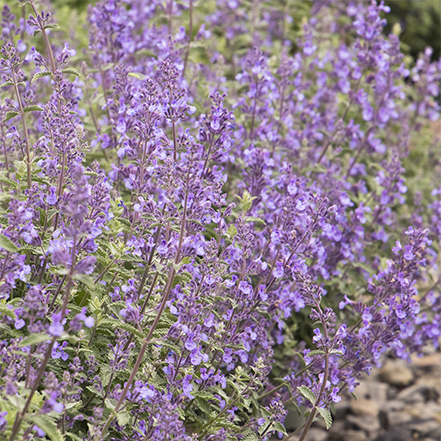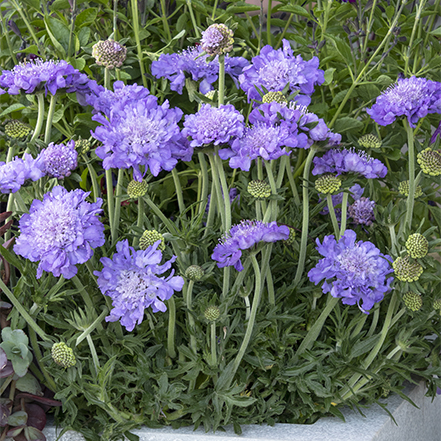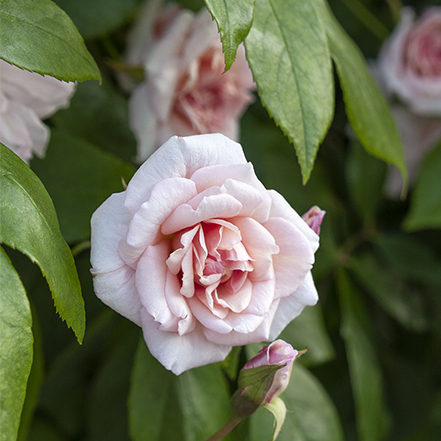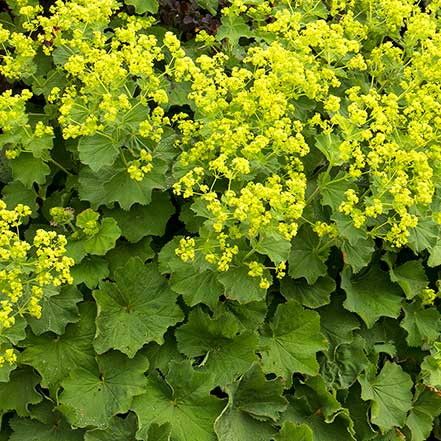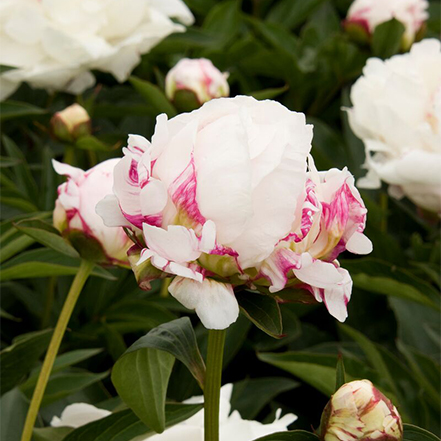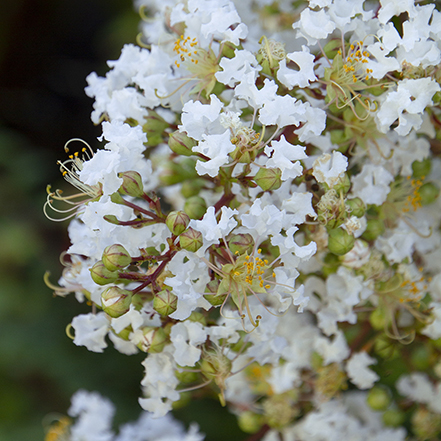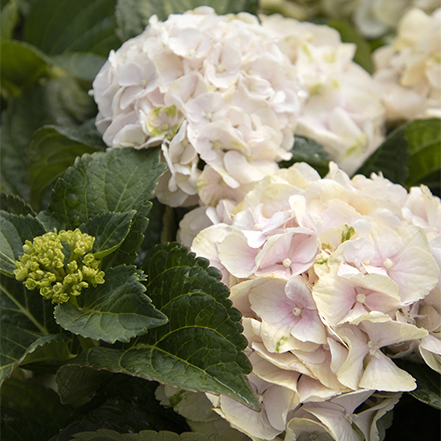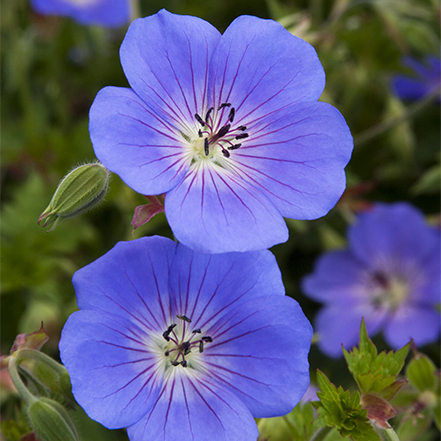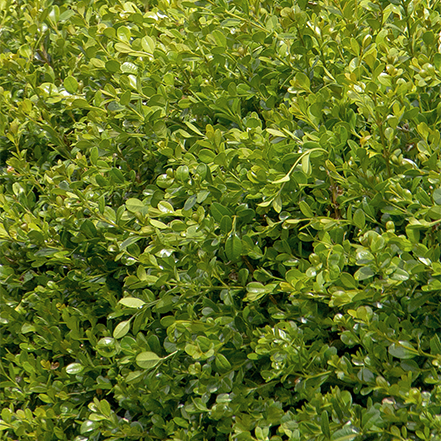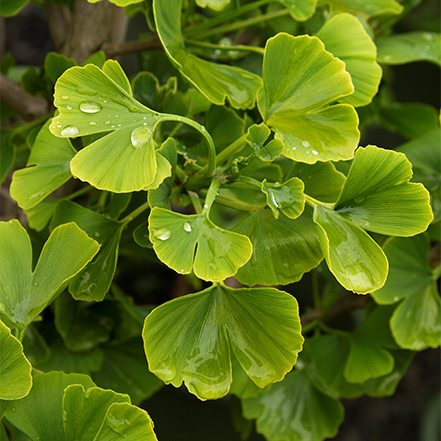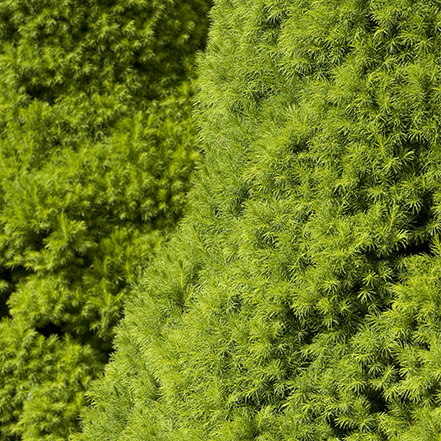Formal garden design may seem daunting at first. But once you get into the unifying elements, you'll find that it's actually one of the simplest design concepts. The secret to a timeless formal garden is what we call "Architectural Simplicity." Or, the use of symmetry, topiary, sculptural plants, and a limited plant palette. Use this to achieve a sense of classic appeal and history in a garden. No matter how long it's been there.
(Above) Petite Pillar™ Dwarf Boxwoods and Blackhawks Big Bluestem grass offer soft, symmetrical structure. Placed in front of the vibrant Grace N' Grit™ Pink Shrub Rose in a sleek container.
Ready to learn how to give your space a feeling of refined elegance without the frustration of complicated design plans? We lay it all out for you right here, including design tips, professional landscape inspiration, and plant lists. Plus, you can find a full landscape design plan and plant list for a formal Architectural Simplicity garden. Plus four other distinctive styles in our (free) Landscape Style Guide lookbook.
Get the Look: Architectural Simplicity
One of the more formal approaches to garden design, the style called Architectural Simplicity is elegant and timeless. It evokes a romantic ideal of British gardens framed by clipped boxwood hedges. Or, an Italian summer afternoon in a courtyard lined by cypress or juniper. The key rules at play here are symmetry and repetition. This makes this style easier than others to adopt and execute in a rectangular or square space. You don't need a lot of space to create a grand feeling. However, you will want to keep clippers handy to maintain a tidy look.
5 Simple Tips for Timeless Formal Garden Design
- Use symmetry and geometry in your planting plan
- Choose one or two evergreens as your main element, and repeat in rows or borders
- Add punctuation or statement plants. Such as a topiary form in a globe, spiral, or pyramid, around seating areas or entries
- Choose flowering shrubs (if using) with blooms in white or cooler hues
- Soften the formality a touch with soft textures like billowing grasses, flowering vines, and low-growing perennials.
Take a look at the three gardens below for inspiration. Plant lists for accomplishing a similar look in your space. How many of the tips outlined above can you find in each space?
1. Resplendent Old World Revival
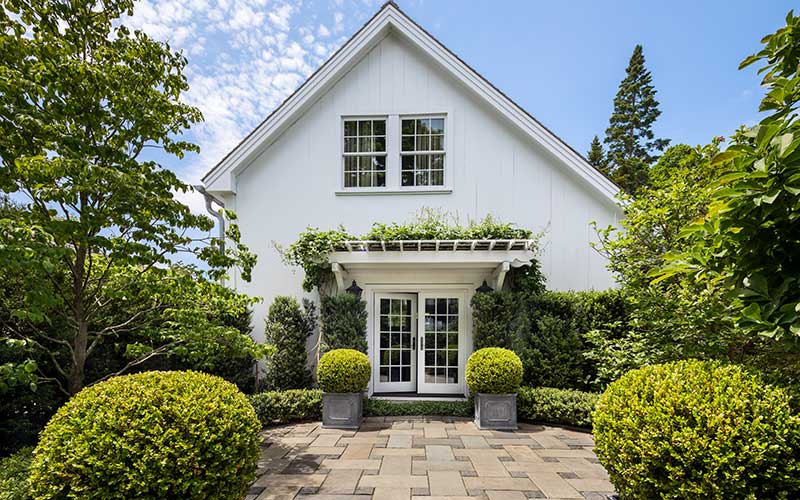
This 19th-century Greek Revival house in Essex, CT was re-designed to "reflect the building's 1845 beginnings." It has an elegantly landscaped surrounding property to match its historical charm. In the courtyard photographed above, evergreen boxwoods punctuate the space. Just as perfectly symmetrical globe topiary forms (Green Mountain Boxwood makes great globe topiaries). Tall hedges and deciduous trees create green outdoor walls for privacy and a feeling of enclosure. Sweet Autumn Clematis rambles over an arbor to soften the structure. It provides the added bonus of a sweet fragrance upon entry and exit from the French doors.
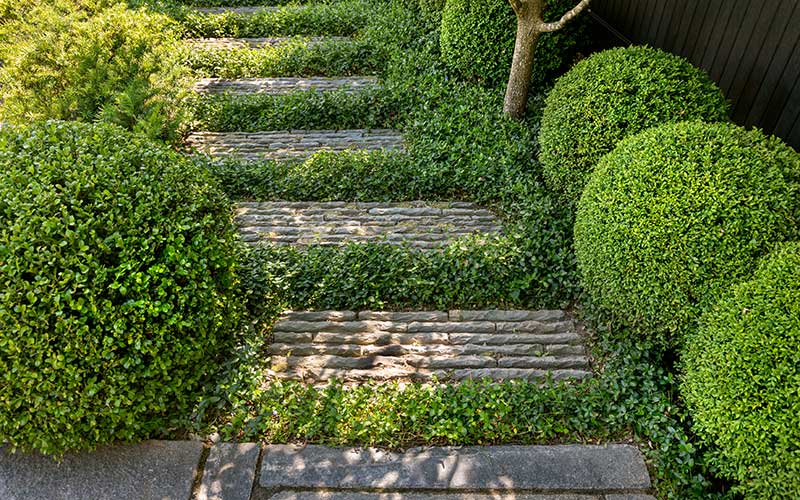
The well-worn pathway pavers, boxwood globe topiaries, spreading yew, and vinca groundcover seen here. They work in harmony to create a sense that this garden has been around as long as the home has. The hardy, fast-growing nature of these plants makes a well-established appearance easy to accomplish in a short amount of time.
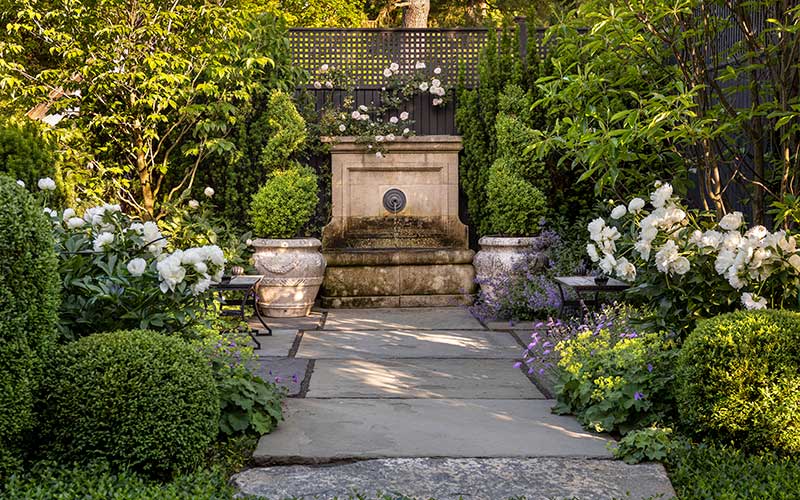
Create serenity with a refined oasis. This combines with the more relaxed cottage garden aesthetic with the precision of a formal garden. Here, you see classic cottage plants like peonies, pincushion flower, lady's mantle, climbing rose, and catmint. These add softness and (not too much) color to the structure, symmetry, and artistry of globe and spiral boxwood topiaries. Notice how the spiral topiaries flank the fountain, subtly drawing attention to the serene focal point.
The shift is subtle yet profound. When the looseness and color of these plants are added to the restrained formality of boxwood topiaries and hedges.
Architect: Robert Orr + Associates
Photographer: Peter Aaron
9 Plants to Get this Look
Green Mountain
Boxwood
A vigorous evergreen shrub with bright green foliage that retains its color through winter. It's perfect for formal topiary forms thanks to its naturally dense, cone-shaped habit. Also ideal for containers. Up to 5' tall, 3' wide unpruned. Zones 4-9.
Spreading Japanese
Plum Yew
An attractive, versatile, and problem-solving evergreen shrub with long, dark green needles that look great in foundation or mass plantings. Shade, heat, and drought tolerant. Excellent for filling under tree canopies or as a low hedge plant. Up to 3' tall, 4' wide. Zones 6-9.
Sweet Autumn
Clematis
A showy climbing vine that displays billowy masses of fragrant, pollinator-favorite flowers against leathery dark green leaves in late summer. Grows rapidly in warm temperatures with twining stems that quickly cover fences, arbors, and sheds. Up to 20' tall with support. Zones 4-9.
Green Tower®
Boxwood
The narrow, columnar growth habit of this lustrous boxwood makes it an ideal specimen. Especially for formal topiary shapes, like the spirals seen flanking the fountain above. Also great for hedges and privacy screens. Up to 9' tall, 2' wide unpruned. Zones 5-9.
Walker's Low
Catmint
A low-maintenance and pollinator-friendly perennial with showy periwinkle blue flower spikes and fragrant gray-green foliage. Great for adding soft, cascading color to walls, borders, and containers. Up to 2' tall, 3' wide Zones 4-9.
Giga® Blue
Pincushion Flower
The largest pincushion flowers on the market! The charming, honey-scented, violet-blue, and 3" flowers are held on stiff, upright stems above fine foliage. Up to 20" tall, 15" wide. Zones 4-9.
Cecile Brunner
Climbing Rose
A favorite for climbing over a trellis or arbor in cottage and formal gardens. The small buds open to fragrant, light pink, double blooms in large sprays. A great rose for cutting, especially for mini bouquets. Flexible canes can reach up to 20' long, 6' wide. Zones 4-11.
Thriller
Lady's Mantle
A dependable favorite for cottage gardens, with vivid golden-yellow flowers in airy sprays above scalloped, shiny leaves. Creeping habit and form are perfect for edging a border or pathway. Also ideal for cut floral arrangements. Foliage reaches up to 2' tall and wide; flowers rise above the foliage. Zones 3-9.
Shirley Temple
Double Peony
Huge, white, double blooms have a hint of rose that adds an intriguing visual dimension. The lush mound of glossy green foliage is deer resistant. A favorite for cut flower arrangements. Up to 2' tall, 3' wide. Zones 4-8.
2. Lead the Eye with Simple Symmetry
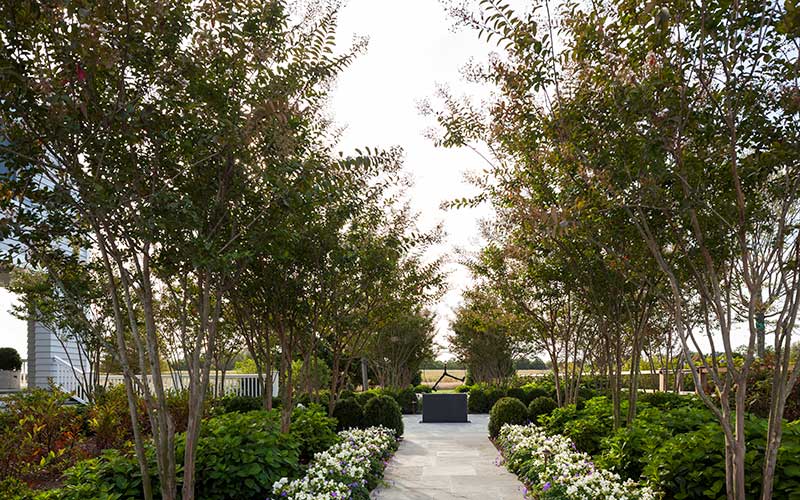
You'll often find striking sculptures and pieces of art in formal gardens. They look perfectly at home with the living art of topiaries and sculptural plants. These works of art can be spotlighted with plants just as they would with a light in a museum. Look at the "Family Compound Bridgehampton" property above. You can see how a simple plant palette and symmetrical mass plantings draw the eye to a sculpture. It invites one to pause and enjoy the sculpture and the space.
A circle of evergreen shrubs surrounds the space for enjoying and observing. While swaths of hydrangeas (not in flower here), begonias, and cranesbill lead the eye (and the feet). Leading directly to the pièce de résistance. Small, multi-stemmed crape myrtle trees create a feeling of focus for the visitor, directing all attention forward.
Photographer: Eric Piasecki
3 Plants to Get the Look
Natchez
Crape Myrtle
Perfect for mass planting in symmetrical rows. This small tree has smooth dark, cinnamon brown, exfoliated bark, and glossy dark-green leaves. These turn a vibrant orange-red in fall. Panicles of pure-white flowers bloom all summer. Up to 20' tall and wide. Zones 6-9.
Seaside Serenade®
Cape Lookout Hydrangea
Showy and sturdy, with long-lasting, large blooms, and thick dark-green foliage. Mass in the landscape to create rows of color and foliage. A go-to plant for refined gardens. Up to 3.5' tall and 3' wide. Zones 4-9.
Rozanne
Cranesbill
A dependable and low-maintenance groundcover that forms lush mounds of deep green foliage that is lightly marbled chartreuse. Violet flowers offer color from early spring through summer. Up to 20" tall, 24" wide. Zones 4-10.
3. Formal Topiaries for Elegant Small Spaces
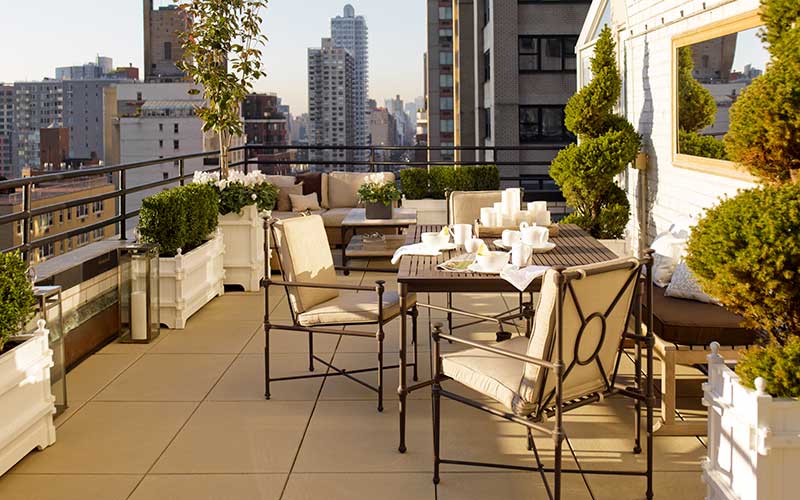
You can implement the formal elegance and charm of architectural simplicity. No matter how small a patio, rooftop, or outdoor room. It's actually quite easy, as long as you have some large containers and the right plants. The outdoor rooftop living space above executes the style perfectly. With a simplified plant palette that includes clipped boxwood hedges, a small accent tree, and spiral spruce topiaries. We love the way the plants act as the green color pop in the otherwise neutral color palette. An elegant design approach like this one is perfect when you don't want to distract from an expansive view.
Photo by Eric Piasecki
3 Plants to Get the Look
Winter Gem
Boxwood
An ideal boxwood for small, evergreen topiaries and hedges. Great for containers in rooftop and small gardens thanks to its compact habit. Rich green foliage can acquire a golden bronze in cold winters and quickly becomes green in spring. 4-6' tall and wide. Zones 5-9.
Jade Butterfly
Ginkgo
A dwarf, densely branched variety that does well in containers thanks to its slow-growing, compact habit. This fruitless male ginkgo has striking bright green leaves that turn gold in fall. 12-15' tall, 10' wide. Zones 4-9.
Dwarf Alberta
Spruce
A perfect cone-shaped dwarf conifer that is artistically pruned by Monrovia craftsmen into topiary shapes. (Like the spirals in the rooftop garden above). This is done over several years to make a formal statement in the garden. They are superb container specimens for patios, entrances, and rooftops. Up to 8' tall, 5' wide unpruned. Zones 2-8.
Need more garden design help? Check out these resources:
- Find your local garden center to ask if they carry the featured plants.
- Sign up for the Grow Beautifully newsletter. You'll get first access to exclusive digital design guides and webinar invites. Plus receive helpful stories like these delivered straight to your inbox.
- Browse stories with lessons from garden design experts
Free Digital Design Guides:
- Landscape Style Guide Lookbook (get a landscape plan and plant list for an Architectural Simplicity garden design here)
- Simply Beautiful Design Guide
- Plant Palette Color Guide
- Drought-Tolerant Gardening Guide
Webinars:




